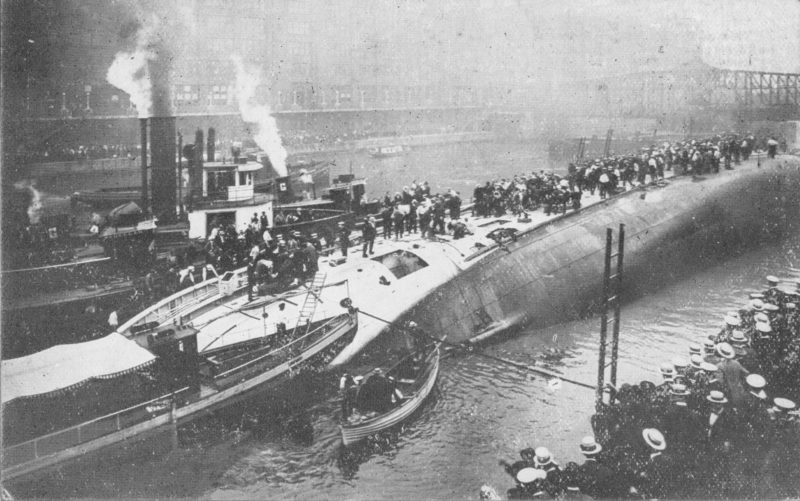
What started out as a day of celebration for more than 2,500 workers of the Western Electric Company turned into the deadliest disaster in Chicago history. On the morning of July 24, as workers and their families gathered aboard the SS Eastland for a trip to Michigan City, Ind., problems with the ship's weight and ballast tanks – which had been emptied before the launch – caused the ship to roll over while it was docked in the Chicago River.
Little known today, one of the great disasters in U.S. history occurred 100 years ago this week in Chicago, and caused heartbreak and anxiety throughout Illinois including Champaign-Urbana.
Although no one from here perished in the tragedy that struck the S.S. Eastland as it sat moored to a dock on the main branch of the Chicago River, for days afterward local newspapers carried stories about friends or relatives who were missing, or who had intended to board the boat that Saturday morning for an excursion across Lake Michigan.
Even today there is some dispute about the number of people who died when the sleek boat, called "The Speed Queen of the Great Lakes," capsized in about 20 feet of water between Clark and LaSalle streets on the south side of the river. Most accounts say 844 people died, others say 848. In those days following the accident there were newspaper reports that as many as 1,338 lost their lives.
Even so the death toll was greater than the number (766) who died in the Great Chicago Fire 44 years earlier, and is still considered one of the worst accidents (in terms of lives lost) in U.S. history.
Almost all the dead were employees or family members of employees who worked at the gigantic Western Electric plant just outside of Chicago, where telephone equipment was manufactured. Five boats, including Eastland, had been chartered to carry an estimated 7,000 people to the picnic at Michigan City, Ind.
There was immediate concern that recent University of Illinois graduates who worked at Western Electric would be among the dead.
"Walter J. Blum, who completed a course in electrical engineering at the university in 1914, and F.J. Naprsteck, who finished a course in architectural engineering in the same year, are among the former university students working for the Western Electric Company for whom no word has been received since the disaster this morning," The Champaign Gazette reported hours after the accident.
A few days later, however, local papers reported that they and others were safe. The manager of the student apprentice program at Western Electric, which included 30 UI students, wired: "All Illinois men checked up as safe."
Then came stories of narrow escapes, people who attempted to rescue survivors and local undertakers who were enlisted to care for the dead.
The sister of Champaign Police Chief A.U. Keller initially was reported among the missing "until an inquiry by wire brought the information that Miss Keller was not on the ill-faced boat. She had purchased a ticket but for some reason did not go aboard," the Urbana Daily Courier reported.
Another story said that Frank Holmgren, a young man from Rantoul, had been on the Eastland but was thrown into the river as the boat "turned turtle."
"Holmgren was on the upper deck and when thrown into the water he easily swam to the dock," the Courier said. "He and another young man were with a couple of young lades when they were thrown into the water and became separated from them, both the girls being drowned. Homlgren has been in Chicago only a few months and was employed at the Western Electric plant. He is well known (in Rantoul), having at one time had charge of a local moving picture show."
Mrs. Carrie Hatch, a nurse at the Cook County Psychopathic Hospital, wrote to her daughter in Urbana following the accident, and her letter was reprinted in the Courier.
"You can't imagine the dark pall of death that hung over the city yesterday. No theatre, no park open, nothing but hearses and ambulances flying in every direction," she wrote. "I went in my uniform and was allowed anywhere. I went on both bridges and saw the old ship on its side with 700 bodies underneath. I saw the divers bring up many bodies.
"Then I went to armory No. 2 on through the morgue and looked at the poor unidentified bodies, mangled and bleeding — people looking into every black and mangled face for their loved one. I never beheld such a sight of repulsion in all my life."
Urbana undertaker C.A. Fry left town to care for the dead, the Courier said."When the appalling number of dead was realized, Coroner Peter Hoffman of Cook County sent appeals for help to downstate undertakers, and the Urbana man responded. Mr. Fry individually prepared the bodies of 10 victims for burial," said the Courier.
A book on the Eastland, written 20 years ago by George W. Hilton, concluded that the disaster was caused by post-Titanic modifications — including the addition of lifeboats and life rafts — that made it top-heavy and unstable.
Civil lawsuits following the accident gave little comfort to the victims and their families. Laws at the time limited liability to the value of the ship, $46,000, and claims by the salvage company that towed the Eastland away took precedence. There was little money left for the families of middle- and lower-class victims, many of them immigrants with names like Buszkiewicz, Grochowksi, Cmucha, Stejskal, Cifrik and Zdrojewska.
Tuesday 21 July 2015
http://www.news-gazette.com/news/local/2015-07-19/tragedy-chicago-echoed-c-u-100-years-ago.html


